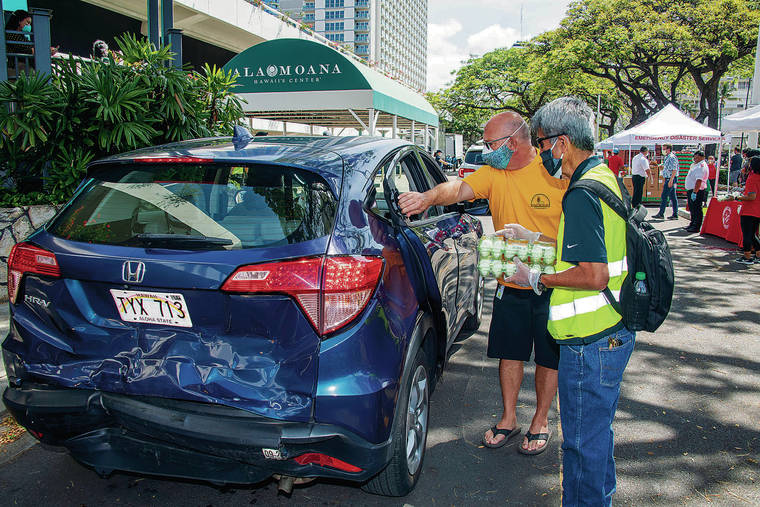Editorial: Connect Hawaii farmers with the hungry during COVID-19 pandemic

CRAIG T. KOJIMA / CKOJIMA@STARADVERTISER.COM
Drivers lined up along Kapiolani Boulevard through Ward Avenue on Saturday for the Salvation Army’s drive-through food distribution event at Ala Moana Center’s Atkinson Drive trolley area.
Life has been turned upside-down in this pandemic Opens in a new tab, on public-health and economic fronts. None of that has changed the basic need for food — but filling it has become a challenge.
On Saturday, along Kapiolani Boulevard and Ward Avenue, traffic snaked back from Ala Moana Center’s parking lot. The cause of that traffic was a free distribution of eggs, bread, milk and potatoes by the Salvation Army — food donated by Chad and Stephanie Buck, heads of the food distribution company, Hawaii Foodservice Alliance.
The line of cars was a stunning demonstration of the demand. Opens in a new tab Many people have lost jobs — more than 237,000 are newly unemployed here — or at least part of their pay. They are feeling insecure about their food budgets in Hawaii, where high costs squeeze available income even in the best of times.
The same experience is being felt across the country, which means that food banks and charity food pantries are being hit with skyrocketing demand.
Compounding this national need is a coinciding glut of produce ready for harvest when farms are suddenly left without their usual markets. Restaurants, schools, hotels and other institutional customers are shut down and not ordering food, and farms thus can’t be assured of the revenue to pay field laborers to reap and process the crops.
That’s happening to some extent on Hawaii farms, but the Hawaii Foodbank has invested $200,000 for purchases from farmers through the Hawaii Farm Bureau. That was a lifeline the local farmers really needed; Hawaii restaurants and other conventional local-grown produce customers have gone dark, too.
Don't miss out on what's happening!
Stay in touch with breaking news, as it happens, conveniently in your email inbox. It's FREE!
Megan Kono, the bureau’s Farmers Market general manager, said because of its new Farm to Car system of online produce sales, farmers in its program are busier than ever with sales, while she added there are anecdotes of farmers here, too, who have to forego harvesting a crop.
Supporting local farmers through various means is key to maintaining a level of food sustainability within the islands. These also include “community supported agriculture” delivery programs such as Oahu Fresh, and the remaining open markets that haven’t been shuttered due to the closure of their park sites.
On the whole, however, Hawaii remains largely dependent on food imports. Keeping that supply coming for the low-income families that really need the help will require financial support from those who can afford being a donor.
The reason: Many independent charity food pantries, as well as the nonprofit Hawaii Foodbank, are not receiving the same level of in-kind donations they traditionally do.
Ron Mizutani, the foodbank president and CEO, said households rushing to stock up on nonperishable foods have meant some empty shelves at supermarkets — and that there is much less of a surplus from food distributors to go to the charities.
The foodbank also had to cancel its Great Chefs fundraiser and its annual “Stamp Out Hunger” nonperishables collections through the mail carriers, Mizutani said. This year, inventory shortages have driven the agency to ship in more mainland food, too, in competition with national foodbanks.
Because of bulk purchasing power, he said, the foodbank can leverage cash donations for more food than the retail cost of food items. Donations can be taken online (www.hawaiifoodbank.org/donate Opens in a new tab).
The traditional foodbank public donations drive has been rescheduled for August when, Mizutani hopes, more relaxed restrictions will enable that daylong campaign to take place.
Whichever charity is holding out a hand for food donations, the need is sure to be great for some time — and, sadly, for a greater sector of the community than ever before. Hawaii families will still be hungry for such generosity.



